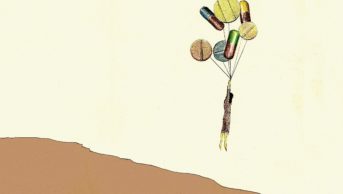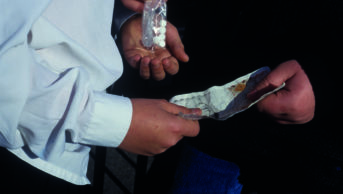
Shutterstock.com
The UK government is pursuing a blanket ban of so-called legal highs. The Psychoactive Substances Bill 2015, introduced in the House of Lords on 28 May 2015, would automatically make it illegal to produce or supply any new psychoactive substance (NPS) intended for human use.
The blanket approach is intended to curb the recreational use of substances designed to be distinct from drugs currently deemed illegal. Among the NPSs are synthetic cathinones, cannabinoids, phenethylamines and opioids.
There is clear evidence that NPS use is a growing trend, driven to a large extent by products currently sold as bath salts or plant food that are available online and in head shops. It is a problem that many national governments are taking steps to address.
Cat and mouse
Under existing UK law, a new psychoactive drug is not illegal unless it is specified in the Misuse of Drugs Act 1971. When NPSs are identified they are usually risk-assessed by a statutory advisory body — the UK Advisory Council on the Misuse of Drugs (ACMD) — and then the Home Office applies a classification. For NPSs, there are limited data available to inform this process on account of difficulties in reporting and confirming a particular NPS’s involvement.
The need to identify and classify newly designed psychoactive drugs has been described by the crime minister Mike Penning as a “game of cat and mouse”. In 2011, the government brought in ‘temporary class drug orders’, a measure that permits a 12-month ban on substances of concern on the advice of the ACMD. The first such order was made for methoxetamine, a substance closely related to ketamine, and any simple derivatives in April 2012. It was formally classified as a Class B drug in February 2013.
The number of NPSs has risen globally year on year, with a total of 348 such substances reported to the United Nations Office on Drugs and Crime by December 2013, up from 251 in July 2012 and 166 in 2009.
According to the latest European Drug Report, published by the European Monitoring Centre for Drugs and Drug Addiction in June 2015, there were 101 NPSs detected in 2014 through the EU early warning system. It is fair to say that governments have failed to assess the safety of NPSs quickly enough to keep up with the ever tweaking of molecules to circumvent the law.
Different European countries have extended existing laws or passed new ones to keep ahead of NPS creators.
The UK government’s plans echo changes brought in by the Republic of Ireland through its Criminal Justice (Psychoactive Substances) Act 2010. A key difference in the Irish law, and in similar legislation in Portugal, is that the NPS effects need to be “significant” for a substance to be deemed illegal. The UK Psychoactive Substances Bill 2015 has no such qualifier in its description of an NPS.
This could prove problematic for its passage through Parliament. The blanket approach, rather than a risk-based one, means that, in theory, even the safest of substances would automatically fall within the new law if they were found to have an action on the central nervous system.
Safety first
But this is not to suggest that legal highs are safe.
There have been hospital admissions and deaths from various NPSs, yet there is great harm caused by many legally available psychoactive drugs, such as alcohol, and this evidence of harm is not used as grounds for prohibition. Conversely, some illegal drugs, like cannabis and ecstacy, may well be safer than many of the drugs currently being touted as ‘legal’. People take legal versions because they do not wish to break the law, which in fact puts them at risk.
Although the bill does not make possession for personal use illegal per se, it does make it an offence to “produce, supply, offer to supply, possess with intent to supply, import or export” any substance that is capable of producing a psychoactive effect. Such a move could have serious consequences for many young people who are bound to experiment and who may be unable to prove they obtained the NPS for personal use. Nor is the bill designed to address the threat posed to young people by these drugs — quality issues may be exacerbated the further underground drug manufacturers go.
Much depends on how the UK prosecution services choose to interpret the new law, if it comes to pass, and the case law that then evolves.
Disregarding the challenge of proving a person’s intent, there would also be difficulties in assessing the psychoactivity of substances. Who will undertake a timely assessment and how will this be validated and verified? Home Secretary Theresa May has written to the ACMD seeking its views on how best to “establish a comprehensive scientific approach for determining psychoactivity for evidential purposes”.
New Zealand is taking an entirely different approach. Its Psychoactive Substances Act 2013 introduced a regulated route for people to access NPSs that have been shown to have a low risk of harm. To date, no applications for product approvals have been received by the Psychoactive Substances Regulatory Authority of New Zealand. All NPS product approvals that existed on an interim basis have been revoked or refused.
The proposed UK law is designed to stamp out recreational drug use, irrespective of the harms these drugs might represent to the people who choose to use them. What one person might view as a puritanical measure out of sync with reformist attitudes, another may consider just plain sensible. Given the inexorable rise of potentially harmful party drugs, it remains to be seen whether UK parliamentarians are convinced by the latter.


